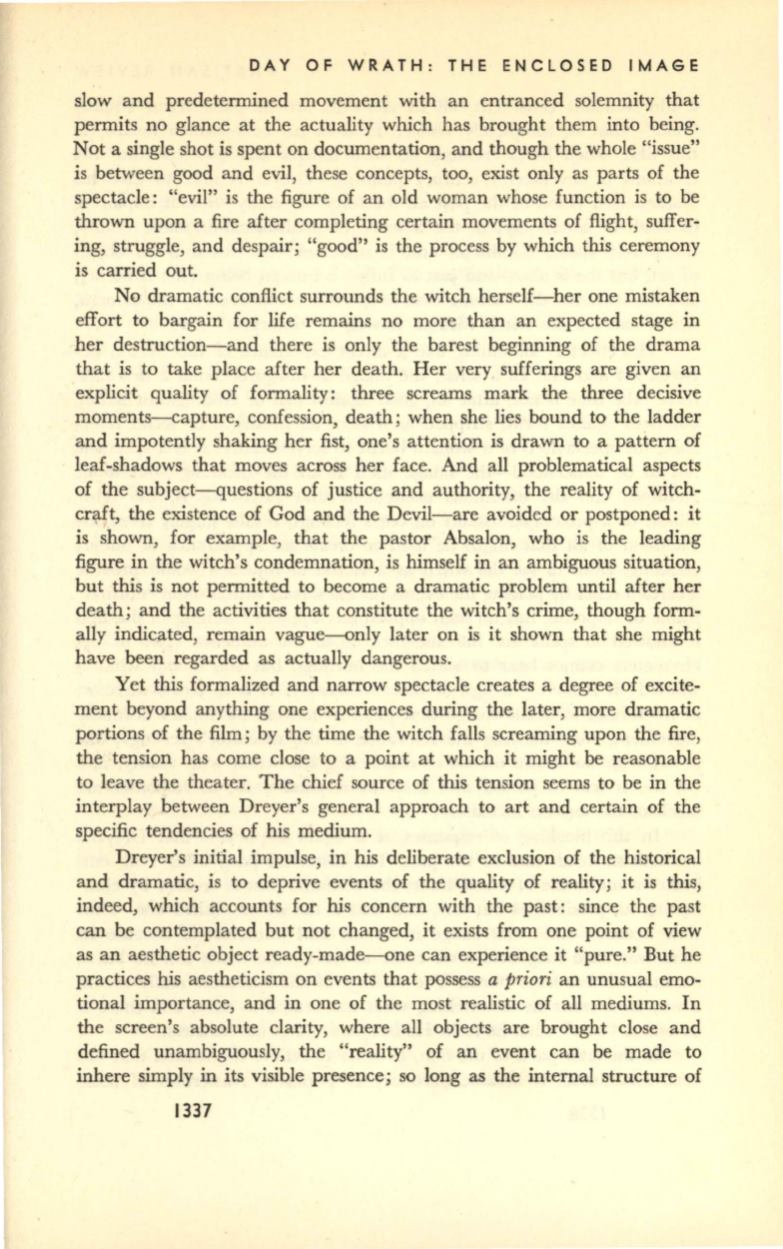
DAY OF WRATH: THE ENCLOSED IMAGE
slow and predetermined movement with an entranced solemnity that
permits no glance at the actuality which has brought them into being.
Not a single shot is spent on documentation, and though the whole "issue"
is between good and evil, these concepts, too, exist only as parts of the
spectacle: "evil" is the figure of an old woman whose function is to be
thrown upon a fire after completing certain movements of flight, suffer–
ing, struggle, and despair; "good" is the process by which this ceremony
is carried out.
No dramatic conflict surrounds the witch herself-her one mistaken
effort to bargain for life remains no more than an expected stage in
her destruction-and there is only the barest beginning of the drama
that is to take place after her death. Her very sufferings are given an
explicit quality of formality: three screams mark the three decisive
moments--capture, confession, death; when she lies bound to the ladder
and impotently shaking her fist, one's attention is drawn to a pattern of
leaf-shadows that moves across her face. And all problematical aspects
of the subject-questions of justice and authority, the reality of witch–
cr~t,
the existence of God and the Devil-are avoided or postponed: it
is shown, for example, that the pastor Absalon, who is the leading
figure in the witch's condemnation, is himself in an ambiguous situation,
but this is not permitted to become a dramatic problem until after her
death; and the activities that constitute the witch's crime, though form–
ally indicated, remain vague-only later on is it shown that she might
have been regarded as actually dangerous.
Yet this formalized and narrow spectacle creates a degree of excite–
ment beyond anything one experiences during the later, more dramatic
portions of the film; by the time the witch falls screaming upon the fire,
the tension has come close to a point at which it might be reasonable
to leave the theater. The chief source of this tension seems to be in the
interplay between Dreyer's general approach to art and certain of the
specific tendencies of his medium.
Dreyer's initial impulse, in his deliberate exclusion of the historical
and dramatic, is to deprive events of the quality of reality; it is this,
indeed, which accounts for his concern with the past: since the past
can be contemplated but not changed, it exists from one point of view
as an aesthetic object ready-made-one can experience it "pure." But he
practices his aestheticism on events that possess
a priori
an unusual emo–
tional importance, and in one of the most realistic of all mediums. In
the screen's absolute clarity, where all objects are brought close and
defined unambiguously, the "reality" of an event can be made to
inhere simply in its visible presence; so long as the internal structure of
1337


